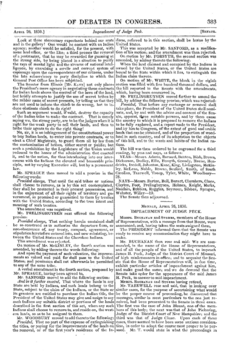Indian Removal Act facts for kids

The Indian Removal Act was a law in the United States that was passed in 1830. It became a law when President Andrew Jackson signed it. It gave the President the power to force Native American tribes to move to land west of the Mississippi River. Not all American citizens liked the law. Davy Crockett, a Congressman from Tennessee, hated the law. Some tribes signed treaties with the United States and moved; others fought with the government, including the Cherokee Nations, which was forced to march west in 1838. Their trip west is now called the "Trail of Tears".
Support and opposition
The Removal Act was strongly supported in the South, especially in Georgia, which was the largest state in 1802 and was involved in a jurisdictional dispute with the Cherokee. President Jackson hoped that removal would resolve the Georgia crisis. Besides the Five Civilized Tribes, additional people affected included the Wyandot, the Kickapoo, the Potowatomi, the Shawnee, and the Lenape.
The Indian Removal Act was controversial. Many Americans during this time favored its passage, but there was also significant opposition. Many Christian missionaries protested against it, most notably missionary organizer Jeremiah Evarts. In Congress, New Jersey Senator Theodore Frelinghuysen, Kentucky Senator Henry Clay, Tennessee Congressman Davy Crockett spoke out against the legislation. The Removal Act passed only after a bitter debate in Congress. Clay extensively campaigned against it on the National Republican Party ticket in the 1832 United States presidential election.
Jackson viewed the demise of Indigenous nations as inevitable, pointing to the advancement of settled life and the demise of tribal nations in the American northeast. He called his Northern critics hypocrites, given the North's history regarding tribes within their territory. Jackson stated that "progress requires moving forward."
Humanity has often wept over the fate of the aborigines of this country and philanthropy has long been busily employed in devising means to avert it, but its progress has never for a moment been arrested, and one by one have many powerful tribes disappeared from the earth... But true philanthropy reconciles the mind to these vicissitudes as it does to the extinction of one generation to make room for another... In the monuments and fortresses of an unknown people, spread over the extensive regions of the West, we behold the memorials of a once powerful race, which was exterminated or has disappeared to make room for the existing savage tribes… Philanthropy could not wish to see this continent restored to the condition in which it was found by our forefathers. What good man would prefer a country covered with forests and ranged by a few thousand savages to our extensive Republic, studded with cities, towns, and prosperous farms, embellished with all the improvements which art can devise or industry execute, occupied by more than 12,000,000 happy people, and filled with all the blessings of liberty, civilization, and religion?
According to historian H. W. Brands, Jackson sincerely believed that his population transfer was a "wise and humane policy" that would save the Native Americans from "utter annihilation". Jackson portrayed the removal as a generous act of mercy.
According to Robert M. Keeton, proponents of the bill used biblical narratives to justify the forced resettlement of Native Americans.
Vote
On April 24, 1830, the Senate passed the Indian Removal Act by a vote of 28 to 19. On May 26, 1830, the House of Representatives passed the Act by a vote of 101 to 97. On May 28, 1830, the Indian Removal Act was signed into law by President Andrew Jackson.
Implementation
The Removal Act paved the way for the forced expulsion of tens of thousands of American Indians from their land into the West in an event widely known as the "Trail of Tears," a forced resettlement of the Indian population. The first removal treaty signed was the Treaty of Dancing Rabbit Creek on September 27, 1830, in which Choctaws in Mississippi ceded land east of the river in exchange for payment and land in the West. The Treaty of New Echota was signed in 1835 and resulted in the removal of the Cherokee on the Trail of Tears.
The Seminoles and other tribes did not leave peacefully, as they resisted the removal along with fugitive slaves. The Second Seminole War lasted from 1835 to 1842 and resulted in the government allowing them to remain in south Florida swampland. Only a small number remained, and around 3,000 were removed in the war.
Images for kids
-
President Andrew Jackson called for an American Indian Removal Act in his first (1829) State of the Union address.
See also
 In Spanish: Ley de traslado forzoso de los indios para niños
In Spanish: Ley de traslado forzoso de los indios para niños



